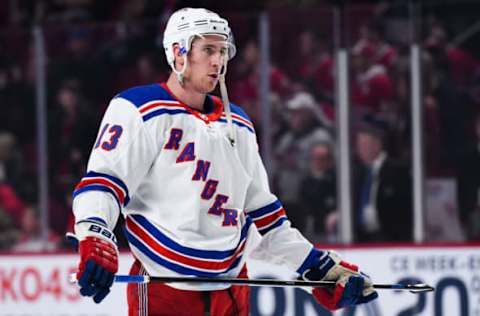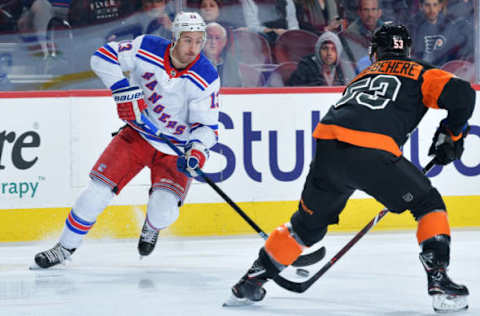New York Rangers: How much should Kevin Hayes get paid?


Kevin Hayes will be an unrestricted free agent after this season. Will the New York Rangers try to re-sign him or will they trade him at the deadline? A lot depends on how much he wants to get paid. How much is he worth?
Should I stay or should I go? Kevin Hayes must be listening to the Clash a lot these days. He is still only 26 and will be a free agent unless he signs a contract with the Rangers before this summer. He came into this season as a restricted free agent and signed a one year deal for $5.175 million after failing to come to terms on a longer term. It was reported that he was seeking a five year deal at about $5.5 million. As of January 1, the Rangers can extend his contract. If they don’t he will likely be dealt at the trade deadline as one of the top forwards available.
When it comes to the fans, it’s pretty much a 50-50 split. He was the best Ranger in both games in Florida. When Hayes plays the way he is capable, he is a dominant two-way center who has the size to control the puck like Jaromir Jagr, soft hands that can make the brilliant pass and an outstanding shot that he doesn’t use nearly enough. As a free agent signee, Hayes has gone a long way towards making up for all of those draft picks the Rangers traded away.
His detractors say that Hayes is a borderline second line center who would be third line on a good team. Although posting a career high 25 goals last season, he never had more than 17 the previous three seasons. Renowned for his passing, Hayes’ top year for assists was just 32 in 2016-17. While the lack of a finisher may be the reason for his career assist totals, those numbers are just okay.
Over the last two seasons, he has become a much better defensive forward and has seen a lot of ice time on the penalty kill. He has also improved immensely in the faceoff circle. In his first three seasons his winning percentage was below 40%. He is now good to win about 50% of his draws.
He hasn’t been a stellar playoff performer. In 34 games he has two goals and eight assists and the last two playoff years for the Rangers, he was a non-factor.
It’s easy to see why there is a debate over whether he should be retained. If he is looking for a $5.5 million salary on a long term, he will impact the salary cap for years and the team will have to make a decision about protecting him in the expansion draft in two years. It’s worth taking a deeper look into how Hayes compares to some other NHLers with the pedigree.

What is the going rate for a 25 goal, 35 assist center?
To set parameters for Kevin Hayes, we looked at his best seasons for goals and points. In 2017-18 he scored 25 goals for a .33 goals per game average. This season is is getting points at a .70 points per game average. So, we looked at which centers of approximately the same age had the same averages in 2017-18.
We found seven centers that had comparable stats:
GPG PPG AGE
- Kevin Hayes 0 .33 0 .70 26 years old
- J.T. Miller 0.28 0.72 25 years old
- William Karlsson 0.52 0.72 25 years old
- Jonathan Marchessault 0.35 0.72 27 years old
- Tyler Johnson 0.26 0.72 28 years old
- Kyle Turris 0.21 0.70 29 years old
- Rickard Rakell 0.44 0.67 25 years old
- Brayden Schenn 0.34 0.67 27 years old
Obviously, these seven players don’t have the identical profile as Hayes, but statistically, it’s a way to determine how much Hayes is worth. Here are their current contracts:
- Kevin Hayes: $5.2 million – 1 year contract 2018-19
- J.T. Miller : $5.25 million – 5 year contract 2018-23
- William Karlsson: $5.25 million – 1 year contract 2018-19
- Jonathan Marchessault: $5 million – 6 year contract 2018-24
- Tyler Johnson: $5 million – 7 year contract 2017-24
- Kyle Turris: $6 million – 6 year contract 2018-24
- Rickard Rakell: $3.8 million – 6 year contract 2016-22
- Brayden Schenn: $5.1 million – 4 year contract 2016-20
At the rate he is scoring, it is unlikely that Hayes will top the 25 goals he scored last season. His career points per game rate is 0.57, lower than all of the players on this list except Miller and Karlsson. Although Hayes’ offensive numbers are lower than this group,they are offset by his abilities as a defensive center. He is arguably one of the best two-way centers in this group.
So, what is he worth?
Is a five-year contract at $5.5 million a year a good deal for both parties? It would be more than all of the comparable centers except for the $6 million Kyle Turris is pulling in from Nashville. However, Turris is 29 years old and signed his deal after a career season with Ottawa.
Rickard Rakell is the biggest bargain in the group. The Ducks were wise to sign him to a long-term contract after a 20 goal season. He has exploded into a top goal scorer with 67 goals over the lkst two years.
Perhaps, the best comparison is former Ranger J.T. Miller who was inked to a long-term deal by the Tampa Bay Lightning. His is close to Hayes in age and their numbers are similar, though Miller is spending more time on the wing than center with Tampa. Ironically, both Hayes and Miller were headed to RFA status this season and the Rangers chose to deal Miller and keep Hayes (or did the Lightning want Miller more than they wanted Hayes?). Of the two, who would you prefer?
It will also be very interesting to watch the William Karlsson contract situation. He was a RFA going into this season and signed a one-year contract similar to Hayes. Unlike Hayes, Karlsson will be a RFA after this season and has yet to prove that last year’s 43 goal season was not a fluke.
Based on these comparisons, Hayes at $5.5 million on a long term deal is not out of line. I’m sure that Jeff Gorton is doing exactly this kind of calculation as the date when they could re-sign him looms. It’s pretty much a foregone conclusion that if the Rangers do not sign him by the trade deadline, he will test free agency. That means that he will be traded no matter what the Rangers are doing in the standings.
One final consideration when it comes to deciding on Hayes is the impact he has on the rest of the roster and where he ends up on the depth chart. With the surplus at center in the organization, signing Hayes to a long term deal means that he needs to remain the second line center because they are paying him top six money. What that means for the development of Brett Howden, Lias Andersson and Filip Chytil is a very serious consideration for the Rangers. If the Rangers truly believe that Andersson will ultimately be a top six center and Zibanejad has a long-term future with the team, then Hayes is centering the third line ahead of Howden or Chytil and that makes no sense at $5.5 million a year.
Next. Three lingering questions before Christmas. dark
It’s an interesting exercise to play general manager. What would YOU do?